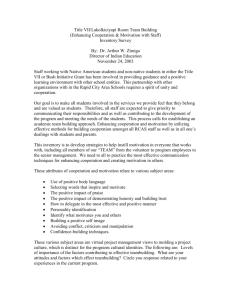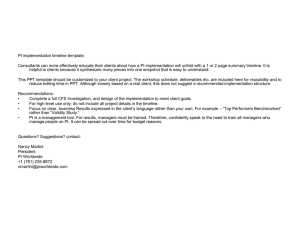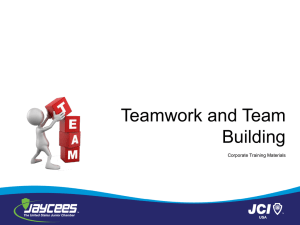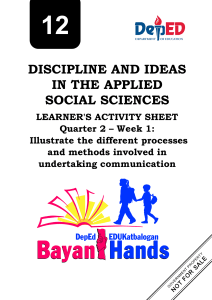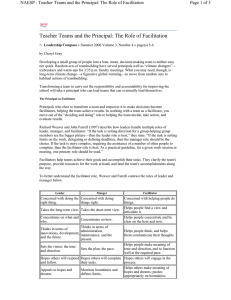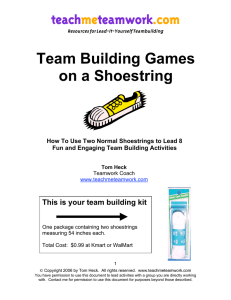Action Planning
advertisement
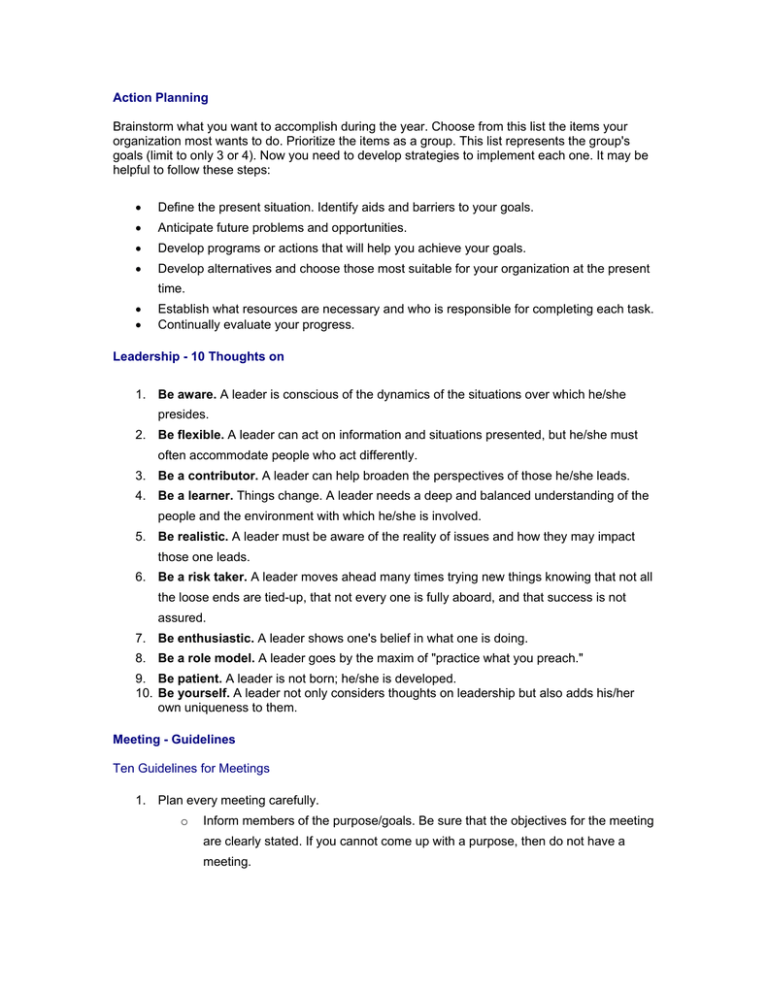
Action Planning Brainstorm what you want to accomplish during the year. Choose from this list the items your organization most wants to do. Prioritize the items as a group. This list represents the group's goals (limit to only 3 or 4). Now you need to develop strategies to implement each one. It may be helpful to follow these steps: • Define the present situation. Identify aids and barriers to your goals. • Anticipate future problems and opportunities. • Develop programs or actions that will help you achieve your goals. • Develop alternatives and choose those most suitable for your organization at the present time. • • Establish what resources are necessary and who is responsible for completing each task. Continually evaluate your progress. Leadership - 10 Thoughts on 1. Be aware. A leader is conscious of the dynamics of the situations over which he/she presides. 2. Be flexible. A leader can act on information and situations presented, but he/she must often accommodate people who act differently. 3. Be a contributor. A leader can help broaden the perspectives of those he/she leads. 4. Be a learner. Things change. A leader needs a deep and balanced understanding of the people and the environment with which he/she is involved. 5. Be realistic. A leader must be aware of the reality of issues and how they may impact those one leads. 6. Be a risk taker. A leader moves ahead many times trying new things knowing that not all the loose ends are tied-up, that not every one is fully aboard, and that success is not assured. 7. Be enthusiastic. A leader shows one's belief in what one is doing. 8. Be a role model. A leader goes by the maxim of "practice what you preach." 9. Be patient. A leader is not born; he/she is developed. 10. Be yourself. A leader not only considers thoughts on leadership but also adds his/her own uniqueness to them. Meeting - Guidelines Ten Guidelines for Meetings 1. Plan every meeting carefully. o Inform members of the purpose/goals. Be sure that the objectives for the meeting are clearly stated. If you cannot come up with a purpose, then do not have a meeting. o Prepare and distribute an agenda to all members (minimum of two days in advance). o Provide appropriate background information. o Be aware of resources and limitations with regard to special projects being considered. o Visuals pay. Explore use of an overhead projector, flip chart and/or slides. Research shows that complimentary visuals can reduce the time spent in meetings. They can facilitate understanding and retention of ideas. o Appoint a recorder or secretary if you do not have one. 2. Reserve room in advance and specify arrangements. o Arrive early to complete set up of the room. 3. Start on time. 4. Introduce members, especially newcomers. 5. Clarify roles and responsibilities. 6. Establish procedural or operating guidelines such as discussion limits. o Learn parliamentary rules and procedures. 7. Concentrate on agenda items. o Recognize differences of opinion but maintain control. o Use conflicts to promote learning. o Keep discussion moving. o Achieve closure on items before moving to another. 8. Summarize before adjourning. o o Recap decisions, assignments and deadlines. Set date, time and place for next meeting. 9. End on time. 10. Complete minutes or written summary of meeting. o Circulate to all members Meetings - Group Dynamics of Other Pointers For Dealing With People in Meetings • Control the garrulous. Some people take a long time to say very little; help them come to a point. • Draw out the silent. Many times silence means one is nervous about giving ideas to the group or he has some hostility toward the group. • Protect the weak. Give all members an equal chance to participate. • Encourage the clash of ideas. Make group meetings a cross flow of discussion and debate, but discourage the clash of member personalities. • Do not squash member suggestions. Give every idea a chance. Come to senior members last. Work up the pecking order • when it comes to ideas or suggestions. Close every meeting on a note of achievement. Thank the group for their work at the meeting or program. Creative Thinking • Defer Judgment: It is important to keep an open mind to all possibilities and avoid using premature evaluation to squelch or inhibit the free flow of ideas. • Look for Lots of Ideas: Letting go of your internal critic will help you to make a deliberate effort to search for many possibilities. Although the ideas may seem common or obvious, that's good because they can be useful in creating new possibilities. It is important to keep track and write down all ideas discussed, so you don't forget them and you can make way to thinking about more ideas. • Accept all Ideas: Be playful and entertain every idea that comes to mind no matter how strange, wild, or silly it may seem at first glance. By recording all these far out solutions, you may reflect, and realize that you can modify them to suit your needs. • Make Yourself "Stretch": Don't limit yourself to just saying a few ideas. Effective problem solving takes an extended effort. New and original ideas often occur when group members are nearing their limits, approaching a state of physical or mental exhaustion. • Calling on all your senses enriches the thinking that you are doing. Seek Combinations: Many people consider the ability to make new connections the very essence of the creative process. Your efforts to think divergently will be enhanced if you combine ideas from various sources to form new possibilities that are even more promising than any of the parts that went into them. Meetings - As you Plan • Plan every meeting carefully: identify goals/objectives, create and distribute an agenda, provide appropriate background information. • Reserve a room in advance and specify arrangements. • Arrive early to set-up. • Start your meeting on time. End your meeting on time. • Introduce members, especially new ones. Introduce executive members. • If it is an opening meeting, have executive members explain their positions and how the membership can get involved. • Establish procedural or operating guidelines such as discussion limits. • If using Robert's Rules of Order pick up a quick reference guide at the LDC. • Concentrate on agenda items: recognize differences of opinion but maintain control, use conflicts to promote learning, keep discussion moving, achieve closure on items before moving to another. • Summarize before adjourning: recap decisions, assignments and deadlines, set • date/time/place for next meeting. Have the secretary compile minutes or written summary of meeting: circulate to all members. Motivating Environment - How to Maintain • Treat each person as an individual. • Recognize that, by nature, people want to do a good job. • Understand that people want to be autonomous and responsible for themselves. • Maintain the self-esteem of others; high self-regard is the cornerstone of motivation. • Constantly communicate both organizational and individual progress toward mutual goals. • Involve people in the decision making process. People usually don't resist their own ideas. • Don't over manage competent people; delegate both work and authority for maximum motivation. • Understand that motivators are relative to the strength of a given need as perceived by the individual. • Recognize that people tend to seek membership in groups that confirm their own values • and validate their own experiences. Encourage a strong sense of shared direction and commitment to peak performance. Programs - Putting Together • Pick up a Program Planning Portfolio in the Leadership Development Center • Determine the type of program your organization/floor needs or wants i.e., community service, fundraising, membership drive, fun stuff, team building, etc. • Determine who your audience is organization members vs. UB students, community • Determine the goals of your program raise $50, get 10 new members • Find resources to handle the program's activities. • Set a date for your program - make sure it won't conflict with other programs. • Determine tentative times dates and hours, for your program. • Locate and reserve an appropriate facility for the program. • Work out the cost of the program, while keeping in mind your available budget. • Determine how many participants are needed for the program to be held successfully. • Arrange publicity for your program, write a UB Brief in The Spectrum. • • Plan on the food and refreshments that you want. Evaluate the program, keep records for next time. Public Speaking • Practice your speech beforehand and time yourself • Use eye contact and look at all the people you're addressing. • Speak vibrantly with energy and enthusiasm. • Walk around to maintain attention. • Use hands to emphasize key points. • Remember non-verbals (posture, signs, facial expressions, head movements). • • Voice-tone, rate, pitch. Look your best!! Speech - Preparing • Do your research on the topic you will be discussing. • Do speak with a language you and the audience share. • Don't try to cover too much information in your speech. • Do know the purpose of your speech: to entertain, to inform, to persuade, to inspire. • Do have a beginning, a middle and an end. • Do create a theme for your speech, and don't be afraid to be creative. • • Do leave time for a question and answer period, if appropriate. Do use visual aids. Teambuilding • Focus on the problem or issue at hand (i.e. member motivation, organization executive board not working together). • Set ground rules for the teambuilding session (i.e., all participants remain actively involved throughout the process). • Have a third party to facilitate the teambuilding session. • Stop by the Leadership Development Center for assistance in selecting teambuilding activities. • • Check out the teamwork videotape and book at the LDC. Teambuilding Activities offered by the Leadership Development Center: o Books o Encyclopedia of Ice Breakers o Quick Start: Ice Breakers & Energizers o Silver Bullets: Guide Initiative Problems, Adventure Games & Trust Activities o Activities Services o Group Juggling o Goal Setting Sessions o Spider's Web o o Officer Responsibility Sessions Trolley Time Management - Steps for Daily • Plan your day the night before, preferably before leaving the office. Begin by scheduling your meetings and appointments, and all "time-related" activities which are out of your control. • Prioritize your daily "Things to Do" list by designating each item as either an "A" (things which must be done) or a "B" (things you would like to do). • Sequence the list in order of importance, always attempting to do the most important things first. • • Estimate the time required for your "A" tasks. Pad that time by at least 30% to allow for interruptions. Schedule the time to work on your important activities. Be realistic, and include time for routine items such as banking, opening mail, checking e-mail, etc. Allow "catch-up" time after being out of the office for extended periods of time. Talking Hints: • When speaking or explaining something, ask listeners for feedback to see if they understand you. • Provide listeners with the opportunity to ask questions or to comment. Do not laugh or get annoyed when questions are asked. Your goal is to have them understand what you are trying to communicate. It is better to be open to questions than to get frustrated later on when they do things differently than you may have wanted. • Consider the feelings of the listener. Put yourself in that person’s shoes. • Look at and focus on the listeners. Do not be distracted by other things. • Have your words match your tone and body language. People will be able to tell that something is not right if these areas do not match. • Use as much detail as necessary to convey your message but try not to go into too much • detail otherwise the listeners may tune you out. Respond to signs of confusion, distraction, or other hints that the listener may not understand you or be paying full attention.

